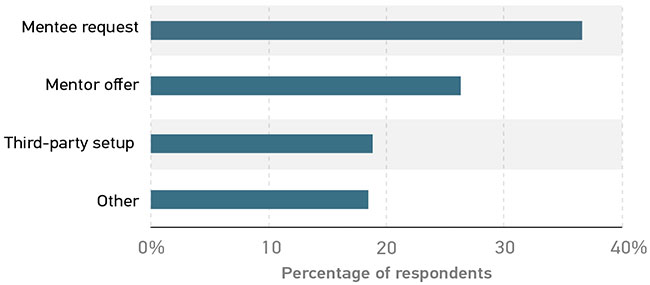How Mentoring Relationships Develop: Proteges Are Seeking You Out!
Connecting with the right mentor can help a protégé grow and excel, both personally and professionally, in ways that may not be achievable alone. With an opportunity to have such a powerful impact on one's career, how does one develop such an important relationship? There is no "right way" to develop a mentoring relationship (figure 5). Mentors and protégés should explore all avenues, including informal means as well as formal invitations, to establish a relationship. In fact, a great number of mentoring relationships come about in an informal and casual manner. These relationships can develop organically and resemble a collegial relationship rather than the expected formalities of a traditional mentee/mentor relationship.

Protégé request was the most frequently reported way in which a mentoring relationship developed for mentors (38%) and mentees (33%). Fewer than a third of mentors (27%) and protégés (24%) told us that the relationship developed through a mentor offer. About one-fifth of each group said that a third party (e.g., supervisor) arranged the relationship or it was enabled through a formal program.
Of the 17% of mentors and 23% of protégés who reported that their relationship developed in an "other" way, one-third reported it developing "organically," "casually," or "informally." This suggests that for those seeking to be mentored, reaching out proactively will likely be a successful strategy. Additionally, keeping alert to the potential of established professional connections and informally leveraging them can lead to a mentor–mentee relationship.
CIOs are reaching out to create mentoring opportunities that, in turn, may build their careers, expand their leadership experiences, extend their professional networks within their institution, and increase engagement with their staff. More CIO mentors (32%) offered to develop the relationship than manager mentors (24%), but more managers (40%) and CIOs (38%) than staff (30%) developed the relationship through protégé request. Managers may want to consider the CIO model of establishing mentoring relationships, which makes mentors more proactive participants in identifying potential mentees. It may also be a salient strategy for those seeking executive positions as their career grows.
Men and women in higher education IT appear to be establishing relationships with mentors in similar ways. This is encouraging, since one of the factors that has been identified as a barrier to women in IT is lack of female mentors.1 Women had slightly higher percentages of mentee requests (41%) than men (37%); more male mentors (29%) than female mentors (23%) reported initiating the mentoring relationship. If we hope to decrease the gender disparities in this workforce and retain female talent, women proactively establishing these relationships among female employees may be one means to address this issue.
Senior women leaders in higher education have noted that having the support of institutional leadership provided formalized professional development opportunities and often early leadership experience.2 Ethnic minorities also indicated that mentorship provided greater opportunities for collaboration (75%), invitations to attend professional and career growth events (58%), and the chance to serve as a co-author on publications (58%).
We found similar disproportions across generations concerning how relationships developed, with more Millennials than other generations engaging in relationship development. More Millennial mentors (33%) than either Gen Xers (28%) or Baby Boomers (24%) told us they offered to develop a relationship. Millennial mentors also received protégé requests (44%) more than Gen Xers (35%) or Baby Boomers (38%). This reveals that younger mentors may be slightly more active in developing relationships, which bodes well for IT departments seeking to develop Millennial employees. Millennials who engage in mentoring may be more committed to their workplace, which translates into higher retention rates for this generation of employees.3 However, similar to the rates across genders, these findings also reflect a minority demographic in the workforce engaging at the same rates as the majority. This can open the door for "reverse mentoring," whereby a younger employee mentors an older, more experienced employee.4 This could benefit the organization by bridging divides between generations in the workplace, as well as empowering Millennials as future institutional leaders.
Notes
-
Manju K. Ahuja, "Women in the Information Technology Profession: A Literature Review, Synthesis and Research Agenda," European Journal of Information Systems 11, no. 1 (2002): 20–34.
↩︎ -
Zambrana et al., "Don't Leave Us Behind," 49.
↩︎ -
Cindy Solomon, "Five Secrets to One Company's 96% Millennial Retention Rate," LinkedIn, February 24, 2017.
↩︎ -
Quast, "Reverse Mentoring"; and Kevin Roose, "Executive Mentors Wanted. Only Millennials Need Apply." New York Times, October 15, 2017.
↩︎